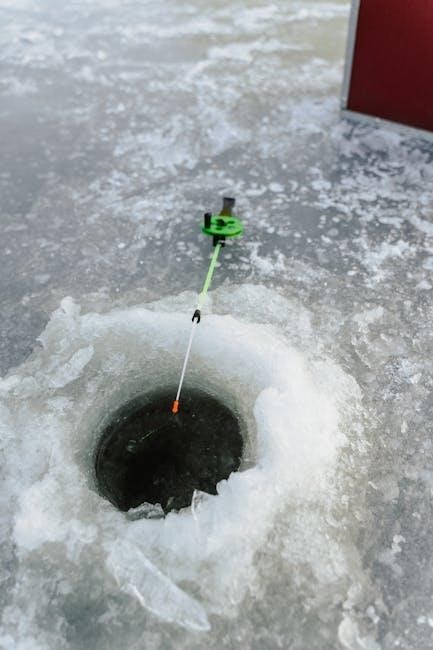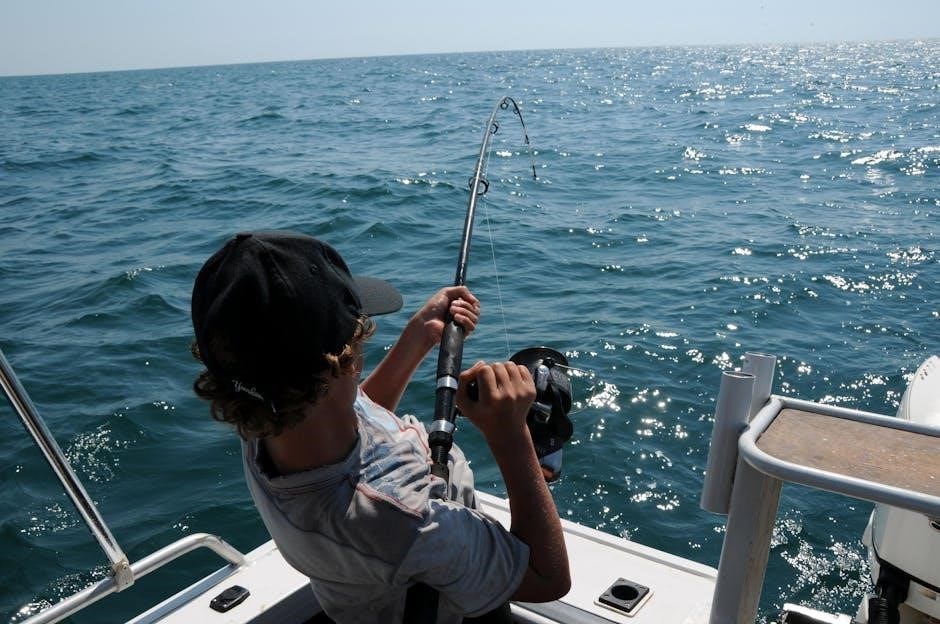Fishing rod guides are crucial components of a fishing rod, influencing casting distance and accuracy, with proper guide alignment ensuring a straight line travel, using
specific
materials and designs effectively always.
Importance of Guides on a Fishing Rod
The guides on a fishing rod play a vital role in the overall fishing experience, as they help to distribute the force applied to the line during casting and fighting fish, which can greatly impact the rod’s performance and the angler’s ability to catch fish. Guides also contribute to a rod’s sensitivity and casting distance, making them a crucial component of the fishing rod. Properly aligned guides ensure a straight plane of travel for the line, reducing friction and minimizing the risk of line tangles and knots. With the right guides, anglers can cast farther and more accurately, increasing their chances of landing a catch. The importance of guides cannot be overstated, as they are a critical factor in determining the overall effectiveness of a fishing rod, and their quality can make a significant difference in the fishing experience. Guides are essential for a successful fishing trip.

Types of Fishing Rod Guides
Various guide types include single foot, double foot, roller, micro, and nano guides, each serving specific purposes, using different materials and designs always effectively.
Single Foot Guides and Their Characteristics
Single foot guides are a type of guide found on fishing rods, characterized by their single foot design, which provides a simple and effective way to guide the line. These guides are typically made from materials such as silicon carbide or ceramic, which offer a smooth surface for the line to pass over, reducing friction and wear. The single foot design allows for a more compact and lightweight guide, making it ideal for use on lighter action rods. Additionally, single foot guides are often less expensive to produce than other types of guides, making them a popular choice for many fishing rod manufacturers. Overall, single foot guides offer a reliable and efficient way to guide the line, and are a common feature on many modern fishing rods, providing a range of benefits for anglers. They are widely used and effective.
Double Foot Guides and Their Advantages
Double foot guides offer several advantages over single foot guides, including increased stability and durability. The two-foot design provides a wider base, allowing for a more secure attachment to the rod blank, which can help to reduce guide twist and improve overall rod performance. This design also allows for a more even distribution of stress and strain on the guide, making it less prone to damage from heavy use. Additionally, double foot guides can provide a smoother line flow, as the two feet help to keep the line in a straight plane, reducing friction and wear on the line. Overall, double foot guides are a popular choice for many anglers, particularly those who fish with heavier lines or target larger species, as they offer a range of benefits that can improve fishing performance and increase catch rates, making them a valuable component of a fishing rod.

Fishing Rod Guide Materials and Quality
Materials like silicon carbide offer super smooth surfaces for less friction on lines during casts using specific
designs
and high-quality materials always effectively.
Role of Silicon Carbide in Reducing Friction
Silicon carbide plays a significant role in reducing friction on fishing rod guides, allowing for smoother line travel and improved casting performance. The use of silicon carbide in guide construction provides a super smooth surface, minimizing friction and wear on the line. This results in reduced heat generation and line damage, ultimately leading to a more enjoyable and successful fishing experience. With its high hardness and resistance to corrosion, silicon carbide is an ideal material for guide rings, providing a reliable and durable solution for anglers. By reducing friction and minimizing line wear, silicon carbide guides help to improve casting distance and accuracy, making them a popular choice among fishing enthusiasts. Overall, the use of silicon carbide in fishing rod guides is a key factor in achieving optimal fishing performance and efficiency. Silicon carbide guides are widely used in modern fishing rods.

Factors to Consider When Choosing a Fishing Rod
Length and action are key factors to consider when selecting a fishing rod, using specific materials and designs to ensure optimal performance always with proper guide alignment and placement systems.
Length and Action of the Rod and Their Impact on Casting
The length and action of a fishing rod have a significant impact on casting, with longer rods generally allowing for longer casts and more accurate placement. The action of the rod, whether it be fast, medium, or slow, also affects the casting distance and accuracy. A fast action rod is more sensitive and allows for longer casts, while a slow action rod is more flexible and better suited for shorter casts. The length of the rod is measured from the end of the handle to the end of the tip, and can range from around 5 to 15 feet. The right combination of length and action can make a big difference in the overall fishing experience, and can help to improve casting technique and increase the chances of catching fish. Using the right rod can also reduce fatigue and make fishing more enjoyable.
Functionality of Guides on a Fishing Rod
Guides facilitate smooth line travel and distribution of force during casting and fighting fish using specific materials and designs effectively always with
proper
alignment.
Distribution of Force Applied to the Line During Casting and Fighting Fish
The distribution of force applied to the line during casting and fighting fish is a critical aspect of fishing rod guides, with guides serving to distribute the force along the blank, reducing stress and pressure on the line and rod. This distribution of force is essential for effective casting and fighting fish, as it allows for a smooth and controlled transfer of energy from the rod to the line. Guides play a crucial role in this process, with their design and placement influencing the distribution of force and the overall performance of the rod. By understanding how guides distribute force, anglers can better appreciate the importance of proper guide selection and placement, and make informed decisions when choosing a fishing rod. Effective guide distribution enables efficient energy transfer and enhances fishing experience.
Impact of Guides on Rod Sensitivity and Casting Distance
Guides contribute to rod sensitivity and casting distance, affecting overall fishing performance with specific materials and designs always.
Contribution of Lightweight and High-Quality Guides to Line Vibration Transmission
Lightweight and high-quality guides play a significant role in transmitting line vibrations to the rod, allowing anglers to detect even the slightest bites and movements of fish. The use of advanced materials and designs in guide construction enables efficient energy transfer, enhancing the overall sensitivity of the fishing rod. As a result, anglers can respond quickly to bites and set hooks effectively, increasing their chances of landing fish. Furthermore, high-quality guides minimize line friction and wear, reducing the risk of line breakage and damage to the rod. By investing in lightweight and high-quality guides, anglers can improve their fishing experience and increase their success rates. The transmission of line vibrations is a critical aspect of fishing, and guides that excel in this area can make a significant difference in an angler’s ability to catch fish. Proper guide selection is essential to optimize line vibration transmission.

